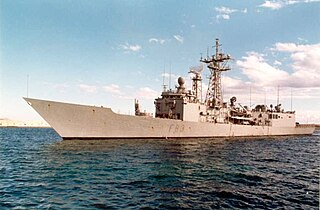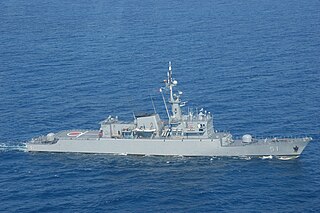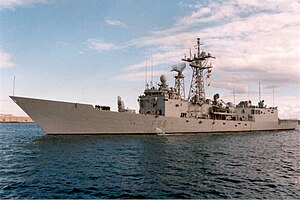
The Santa María class of guided missile frigates is the Spanish Navy's designation for six warships based on the United States Oliver Hazard Perry-class frigates. Spanish ships have a slightly bigger beam and were built with a greater weight reserve for future improvements. Other changes from the basic model include Meroka replacing Phalanx and a RAN-12L air search radar to provide low horizon coverage against sea skimmers cueing the Meroka CIWS mount. The Nettunel EW suite replaced the SLQ-32 system fitted aboard US ships. The first ship Santa Maria entered service in 1986.

Santa María (F81) is the lead ship of six Spanish-built Santa Maria-class frigates of the Spanish Navy, based on the American Oliver Hazard Perry class design. The vessel was constructed in 1982 and was launched on 11 November 1984. Santa María was commissioned on 12 October 1986. The frigate has served in NATO maritime operations.

Reina Sofía (F84) is the fourth of six Spanish-built Santa María-class frigates of the Spanish Navy. The Santa María class is based on the American Oliver Hazard Perry-class design, providing an anti-air warfare platform with anti-submarine and anti-surface warfare capabilities at a reduced cost. Reina Sofía was constructed by Bazan and was laid down on 12 October 1987 and launched on 19 July 1989. The ship was commissioned in 1990 and has seen service in the Mediterranean Sea and off Somalia.

Numancia (F83) is the third of the six Spanish-built Santa Maria-class frigates of the Spanish Navy, based on the American Oliver Hazard Perry class design. The frigate was constructed in Spain by Bazan and was laid down on 8 January 1986, launched on 29 January 1987 and entered service with the Spanish Navy on 17 November 1989. Based at Rota, Numancia has been deployed to the Indian Ocean fighting piracy in Somalia as part of Operation Atalanta and to the Mediterranean Sea intercepting illegal trafficking of migrants as part of Operation Sophia.

Navarra (F85) is the fifth of the six Spanish-built Santa Maria-class frigates, based on the American Oliver Hazard Perry-class design, of the Spanish Navy.

Victoria (F82) is the second of the six Spanish-built Santa Maria-class frigates of the Spanish Navy, based on the American Oliver Hazard Perry class design. Constructed in 1983, the vessel was launched on 23 July 1986 and commissioned on 11 November 1987. The frigate has been assigned to Operation Atalanta, fighting piracy of the Somalian coast.

The Almirante Padilla-class frigates is a series of frigates operated by the Colombian Navy. The designation of this class is Type FS 1500 and there are four ships in service. The ships were built by Howaldtswerke-Deutsche Werft (HDW) at Kiel, West Germany in the 1980s, with the first vessel commissioning in 1983 and the last in 1984. The frigates have undergone significant modification over their careers with the 2012 Orion Program Upgrade significantly modernising the vessels. Two similar ships operate as the Kasturi-class corvettes in the Royal Malaysian Navy.

USS Fanning (FF-1076), a Knox-class frigate, is the third ship of the United States Navy to be named for Nathaniel Fanning.

The Vidar-class minelayers consists of the two ships, HNoMS Vidar and HNoMS Vale built by Mjellem & Karlsen in Bergen for the Royal Norwegian Navy in 1977 and 1978. Used as multi-role ships, the Vidar class were tasked with minelaying, personnel/cargo transport, fisheries protection, torpedo-recovery ships and as anti-submarine warfare escorts in Norwegian service. In 2003, Vale was transferred to the Latvian Navy via donation and renamed Virsaitis and used as a flagship and tender to patrol craft. In 2006, Vidar was transferred to the Lithuanian Navy and renamed Jotvingis and served as flagship and tender to mine countermeasures craft. Both vessels had their ASW equipment removed upon transfer.

The Kortenaer class was a class of anti-submarine frigates of the Royal Netherlands Navy. Like other frigate types of the 1970s and 1980s, they featured a COGOG propulsion system with separate cruise and sprint gas turbines. Ten were built by De Schelde in Vlissingen and two by Wilton-Fijenoord in Schiedam between 1978 and 1982. Only ten served with the Royal Netherlands Navy: two were sold to Greece's Navy while still under construction and replaced by two Jacob van Heemskerck-class frigates which were an air defence variant of the Kortenaer class. The Greek frigates were renamed the Elli class. After service with the Dutch ended, eight of the frigates were sold to Greece in 1992 and the remaining two to the United Arab Emirates. Three of the ships have since been retired from active military service with one converted into the superyacht Yas.

The Cheng Kung-class frigates are eight guided-missile frigates in service in the Republic of China Navy (ROCN). They are based upon the U.S. Oliver Hazard Perry class and built by China Shipbuilding Corporation in Kaohsiung, Taiwan under license throughout the 1990s as part of the Kuang Hua I project. These frigates served as the mainstay of the ROCN's area air defense capability prior to the acquisition of the Keelung (Kidd)-class destroyers in 2005. They are designated with the hull classification PFG rather than FFG used by the Oliver Hazard Perry class.

The Wielingen class is a class of four multi-functional frigates constructed for and operated by the Belgian Naval Component. In service from 1976 to 2008 with the Belgians, three of the class were sold to Bulgaria for service with the Bulgarian Navy beginning in 2004. The fourth, Westhinder, ran aground in 1988, was decommissioned in 1993 and was scrapped.

The João Belo class, also known as Comandante João Belo class, is a class of four frigates of French design, based on the Commandant Rivière class but fitted for tropical service. Ordered by the Portuguese Navy in 1964, the four ships of this class were constructed at the shipyard in Nantes, France between 1965 and 1967. The first ship entered Portuguese service in 1967. The frigates were used for ocean patrol of Portuguese colonies and later, joined NATO's STANAVFORLANT unit. The first unit was discarded in 2003, followed by a second in 2004. The final two ships were taken out of service in 2008 sold to the Uruguayan Navy. The third ship was discarded in 2021, and the last ship was decommissioned on 12 August 2022.

The Inhaúma class are a series of five corvettes operated by the Brazilian Navy. These ships were built in Brazil and designed with assistance from the German company Marine Technik. It was originally planned to build 12 to 16 ships but the economic situation in Brazil did not permit this and only five vessels were built. The first two ships were constructed at the Arsenal de Marinha in Rio de Janeiro, the second pair by Verolme. The programme was considerably delayed due to funding issues and the Brazilian Verolme yard's insolvency in 1991 which forced Júlio de Noronha and Frontin to be completed by Arsenal da Marinha. The first ship entered service in 1989 and the last in 2008. Three of the five ships have been taken out of service and one was sunk in a missile exercise in the Atlantic Ocean in 2016.

The Churruca class was a Spanish destroyer class built for the Spanish Navy based on a British design. Eighteen ships were built, with two being sold to Argentina and commonly referred to as the Cervantes class. The last two members of the class are sometimes referred to as a separate class, the Alava class.

Operation Atalanta, formally European Union Naval ForceSomalia, is an ongoing counter-piracy military operation at sea off the Horn of Africa and in the Western Indian Ocean, that is the first naval operation conducted by the European Union (EU), in support of United Nations resolutions 1814, 1816, 1838, and 1846 adopted in 2008 by the United Nations Security Council. Since 29 March 2019, the operational headquarters is located at Naval Station Rota in Spain, having moved from London as a result of the British withdrawal from the EU.
Dat Assawari was a frigate operated by the Libyan Navy. The ship was built by VT Group in the United Kingdom. It was ordered in February 1968 and delivered in 1973. The ship's design, the Vosper Mk 7 is a modified version of the Alvand-class frigate built for the Iranian Navy. The ship had an extensive refit in Italy by CNR Riva Trigoso 1979–1980 when new sensors and missiles were installed. During the refit, the ship was mined by French commandos from SDECE. The vessel returned to service in 1983, but returned to Italy for repairs in 1984–1985 and 1989–1990. The frigate was reportedly scrapped in the late 1990s.

HNoMS Oslo was an Oslo-class frigate of the Royal Norwegian Navy. The frigate was launched on 17 January 1964, and commissioned on 29 January 1968. Oslo ran aground near Marstein Island on 24 January 1994. One officer was killed in the incident. The next day, on 25 January, she was taken under tow. However as the situation deteriorated, the tow was let go and the frigate sank.

Operation Sophia, formally European Union Naval Force Mediterranean, was a military operation of the European Union that was established as a consequence of the April 2015 Libya migrant shipwrecks with the aim of neutralising established refugee smuggling routes in the Mediterranean. The operational headquarters was located in Rome. The EU mandate for the operation ended on March 31, 2020. Operation Irini is the successor operation.

Méndez Núñez (F-104) is an Álvaro de Bazán-class frigate of the Spanish Navy. She is the fourth ship of her class, entering service in 2006. She is named after the 19th-century Spanish Rear admiral Casto Méndez Núñez. It was the first Spanish Navy vessel to visit the Philippines since the end of the Southeast Asian nation's Spanish colonial-period in 1898.





















